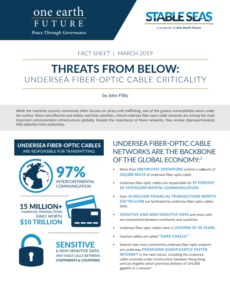More cost-effective and widely used than satellites, critical undersea fiber-optic cable networks are among the most important communication infrastructures globally. Despite the importance of these networks, they receive disproportionately little attention from authorities. In this regard, Stable Seas issued a fact sheet informing of the top risks posed for underwater cable networks and key mitigation measures.
Highlights
- More than 200 private operators control a network of 550,000 miles of undersea fiber-optic cable.
- Undersea fiber-optic cables are responsible for 97% of intercontinental communication.
- Over 15 million financial transactions worth $10 trillion are facilitated by undersea fiber-optic cables daily.
- Sensitive and non-sensitive data and voice calls are transmitted between continents and countries.
- Undersea fiber optic cables have a lifespan of 25 years.
- Inactive cables are called “dark cables.”
- Several new cross-continental undersea fiber-optic projects are underway promising significantly faster internet in the near future, including the undersea cable currently under construction between Hong Kong and Los Angeles which promises delivery of 144,000 gigabits in 1 second.
Top risks
-Accidental & natural damage: Accidental damage presents the greatest historical threat to undersea fiber-optic cables, with numerous incidents of anchor dragging by vessels damaging or severing communication cables.
- The most recent case occurred off the UK island of Jersey in 2016, resulting in significantly reduced internet speeds to and from the island.
- One of the more disruptive incidents took place off the Egyptian coast in 2008:
- Two civilian ships laid anchor in bad weather, subsequently severing five cables that connected Europe, North Africa, and the Middle East.
- Internet was disrupted to 80 million people; Egypt and Pakistan lost 70 percent of their internet and India lost 50–60 percent of their westbound internet connection.
-Malicious damage: Cyber attacks are increasingly identified as the leading threat to the integrity of undersea fiberoptic cable networks. Compromise can manifest as illegal data acquisition for purposes of espionage or criminality, or through disruption or sabotage.
- Given the need for full disclosure to prevent accidental damage by commercial vessels, locations of cables and landing sites are clearly demarcated on maritime maps, making site identification easy.
- Vulnerabilities for intrusion are particularly high at cable landing sites, due in part to significant variability in the level of physical security at landing sites across countries and cable operators.
- Hackers can gain access to, or control over, data and voice traffic either through breaching terminals in cable landing sites or by accessing the data and voice traffic by eavesdropping on/intercepting the fiber-optic wavelengths.
Recommendations
-To mitigate risk of accidental damage to undersea fiber-optic cable requires:
- Burying cables at least 2–6 feet below surface;
- Monitoring for extreme weather events and seismic activity;
-For malicious damage, risk mitigation requires:
- Improving the monitoring of data transmission to detect possible interference;
- Improving the physical security of cable landing sites and monitoring of cables in territorial waters;
- Additionally, there is a need to expand the mandate of regional and international cable protection associations to include aspects of malicious compromise
To improve governance and mitigate the threats to undersea fiber-optic cables, Stable Seas proposes:
- improving legislative enforcement
- expanding the mandate for existing public and private industry associations
- At the country level, steps to improve the disaster and risk resilience of fiber-optic cable networks should include:
–>conducting national risk appraisals concerning the vulnerability of fiber-optic cable network availability;
–>designating cable landing sites as key national security sites;
–>business continuity and disaster-resilience preparedness and training should be routinely conducted: This includes redundancy provisioning of dark cables and network bandwidth for emergency purposes;
–>improvement of cable monitoring.
Explore more herebelow:

































































